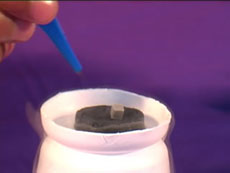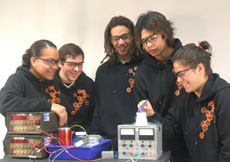Floating on Air | Pūkawekawe
Introduction
Abstract
A superconducting disk is used to levitate a magnet, demonstrating the Meissner Effect.
Principles Illustrated
A superconductor expels magnetic fields and thus “levitates” a magnet above its surface due to the Meissner Effect.
Content
Video
English version
Te Reo Māori Version
Instructions
The magnet is lowered toward the cold superconducting disk and levitates. Small plastic (non-magnetic) forceps can be used to handle the magnet and set it spinning. In addition to the experiment shown in the video, it is very instructive to place the magnet on top of the warm superconductor and then cool the superconductor with liquid nitrogen. The magnet will pop up. This shows that superconductors are not merely perfect conductors as a perfect conductor would oppose the decreasing magnetic flux and hold on to the magnet.

Other Information
Safety
Liquid nitrogen should be handled only by properly trained individuals using standard safety procedures and safety gear. Everyone in the room should be wearing goggles for example. If you are not experienced, trained, and confident with liquid nitrogen, ask a nearby university physics department for help.
Besides the usual cryogenic safety issues one needs to be aware that high temperature superconductors are toxic and one can rub off some of the material on to a finger pretty easily. Students should wear latex gloves if they handle the materials.
Individual teachers are responsible for safety in their own classes. Even familiar demonstrations should be practised and safety-checked by individual teachers before they are used in a classroom.

Related Resources
Compare to the Eddy Current Drag demonstration.
Notes, Applications, and Further Reading
The superconductor used in this demonstration was made at New Zealand’s Industrial Research Limited. There is considerable expertise on superconductors and superconductivity in New Zealand, and in fact the work at IRL lead to a spin-off company called HTS-110 that is now a world leader. They have patents on a number of high temperature superconductors and processes for manufacturing superconducting wire. Note that we are presenting here a simplified story about superconductivity suitable for secondary school students. The expulsion of the magnetic field, for example, is quite complex. But in the ideal case, with a type one superconductor, the expulsion of the field is complete. A more detailed study of superconductors, their use in superconducting electromagnets, and the search for materials that lose their resistance at a higher temperature are all possible starting points for investigations. See for example http://www.superconductors.org/ . Students who are particularly interested in superconductivity might also wish to study superfluids. See for example http://en.wikipedia.org/wiki/Superfluid.
Credits
This teaching resource was developed by the Te Reo Māori Physics Project with support from
- Te Puni Kōkiri
- The MacDiarmid Institute
- Faculty of Science, Victoria University of Wellington
- School of Chemical and Physical Sciences, Victoria University of Wellington
- The New Zealand map shown on the poster frame above is used with permission from www.nz.com.
- The superconductor used in this demonstration was made at Industrial Research Limited.